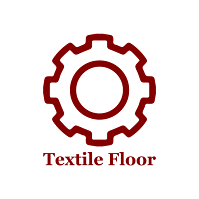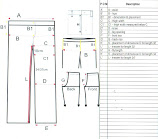In garment manufacturing, achieving high-quality production standards is crucial to meeting both customer expectations and industry requirements. A range of defects can occur at various stages of production, impacting the fit, appearance, and durability of garments. These defects, including fabric holes, fraying, improper pleating, and incorrect stitching, can significantly affect the final product's overall quality. To address these issues effectively, it is important to understand the root causes and implement targeted remedies to ensure consistent, high-quality output.
TQM vs. QMS: Key Differences in Garments Manufacturing Quality Management │Textile Floor│
 In garments manufacturing, ensuring high-quality production
is essential for customer satisfaction and market competitiveness. Two widely
used approaches for achieving quality are Total Quality Management (TQM) and
Quality Management System (QMS).
In garments manufacturing, ensuring high-quality production
is essential for customer satisfaction and market competitiveness. Two widely
used approaches for achieving quality are Total Quality Management (TQM) and
Quality Management System (QMS).
30 Proven Ways to Boost Productivity in Garment Manufacturing and Maximize Profit │Textile Floor│
In this new era of competitive world of garment manufacturing, enhancing productivity is not just a matter of fun or not things of luxury; it’s a necessity for completion, for sustaining in market and obviously for driving profitability. By increasing the efficiency of both labor and machinery, factories can significantly reduce production costs and boost profit margins.
TMU (Time Measurement Unit) and Its Application in Garment Manufacturing │Textile Floor│
What
is TMU?
TMU, or Time Measurement Unit, is a standard unit of time used to measure and
analyze work in industrial engineering. It is primarily used in methods-time
measurement (MTM) systems for assessing and standardizing manual operations.
In the Methods-Time Measurement (MTM) system, it is a small unit of time. Based
on their complexity and amount of effort required, this system gives basic
movements like reaching, grasping, or moving an object a predetermined amount
of time.
How to Reduce Standard Time (SAM) for Garment Production Styles │Textile Floor│
Conduct Motion Study
Identify and eliminate unnecessary motions during sewing operations. Optimise operator movements to reduce operation cycle time. Do Method Study or analyse the operation to record the motion, motion sequence and required time needed for those each motions, re-sequence, eliminate and rearrange the motion therefore do and adjust anything from the findings in your analysing to reduce the process time actually.
Why Determining SAM from Garment Images is difficult │Textile Floor│
It is really a
great challenge to find Standard Allowed Minutes (SAM) from any garment images
because the image cannot provides all proper information needed
SAM is a crucial metric in the garment manufacturing industry, used to determine the standard time required to produce a garment. Though it has some difficulties but it is sometimes needed to find out SAM to do some pre-production activities like costing, order dealing etc.
Style Changeover Time (COT) in Garment Manufacturing │Textile Floor│
Style
change over time (COT) or commonly named Style changing time in the production
line is an important term for production floor in the garments industry. It is
the time of setting all the required machine & equipment with technical
support of new style. Basically the term is the period between the last outputs
of the previous style to first output of the new style. So therefore this is
the time gap when the new setup for new style is done. This period needs to
minimize as possible as less because this time is one kind of wastes. Here IE
team worked closely with other supporting team. Actually the task begins
earlier from the schedule taken from production planning & control team.
In
this article, we will explain why minimizing COT is important, reasons behind
high change over time & how to make Zero the change over time.
What
is Style Changeover Time (COT) actually?
COT is the period
or time gap from the last pcs output of an old style to the first pcs output of
the newly setup style of a garments production line. It involves with various
activities like_ changing machine setup or installment, adjusting tools,
preparing man-machine-materials, and ensuring quality standards aa per required
criteria. This time is critical because every minute of downtime means lost
productivity because the minutes can impact as delays in meeting delivery
deadlines.
In ideal
conditions, Style Changeover Time should be measured in single digits
(minutes), but in many garment manufacturing setups, it stretches to hours,
affecting the overall efficiency of the production process.
Why
Reducing Style Changeover Time is very important in garments industry
Minimizing COT
leads huge benefits to garments manufacturers:
Production
Capacity Enhancement:
Reducing COT means less downtime, allowing machines to produce more units in
the same amount of time.
Improve
Line Efficiency:
Faster changeovers enhance overall line efficiency, helping manufacturers meet
tight deadlines and increase throughput.
Save
on Costs:
Minimizing COT reduces manpower costs, inventory costs, and other expenses
related to downtime and inefficiency.
Enhance
Customer Satisfaction:
On-time deliveries are crucial for customer satisfaction. A quicker changeover
time ensures that orders are completed and shipped on time, leading to repeat
business.
Boost Business Competitiveness: Faster production cycles give manufacturers a competitive edge, enabling them to meet market demands more effectively.
Reasons Behind High Style Changeover Time
Before implementing strategies to reduce COT, it’s essential to understand the factors that contribute to its increase. Here are the most common reasons for high Style Changeover Time in garment manufacturing:
1. Lack of
Multi-skilled Operators
2. Unavailability of
Cut Panels or cut part input
3. Unnecessary
Movement and Poor Workstation Layout
4. Unavailability
of Specialized Machines or Attachments
5. Quality Control
Issues
6. Work-in-Progress
(WIP) from Previous Style
7. Lack of Proper
Pre-planning
8. Unplanned Changes
in the Production Schedule
9. Operator
Training During Changeover
10. Inadequate
Communication between Teams
11. Incorrect or
Missing Information in Style Changeover Plans
12. Prolonged machine setup time, including
adjustments and calibration
13. Lack of
Required Tools and Materials at the workstations
14. Poorly Balanced Production Lines
15. Lack of Spare
Parts or Machine Maintenance
16. Not Using Lean
Manufacturing Principles like SMED (Single Minute Exchange of Dies)
17. Lack of
Standardized Procedures for Style Changeovers
18. Behavior or
attitude of middle management
19. Sudden and
unexpected plan change
20. Product &
Raw Material Diversity
21. Pre-production
activities not fulfill within time
22. Initial product
quality setting and technical support longer.
Key Activities for
Achieving Zero Change-Over Time (ZCO) in Production: Action Plan, Methodology, and
Best Practices:
1.
Timely Operator and Helper Attendance
Ensure all
operators and helpers are present on the production floor by early at start up
time, with production starting promptly to meet first-hour targets.
Action: Implement an attendance sheet
and monitor punctuality.
Responsible
Departments:
Industrial Engineering (IE), Production, Administration.
2.
Optimal Manpower Allocation
Recruit experienced
operators who align with the production line's efficiency requirements. Ensure
that operators and helpers are assigned appropriate roles to avoid skill
wastage.
Action: No helpers should work as
operators and vice versa to maintain quality and efficiency.
Responsible
Departments: IE,
Production.
3.
Preparation for Upcoming Production Styles
Ensure all
materials, including approved samples, trims cards, and production files, are
prepared in advance for new production styles.
Action: Finalize style preparations
before the scheduled input date to avoid delays.
Responsible
Departments: IE,
Production, Quality.
4.
Create Operation Bulletins (OB)
Once style data is
confirmed, the IE and planning teams should develop detailed Operation
Bulletins to guide production.
Action: Ensure OBs are ready to streamline
the production process.
Responsible
Departments: IE,
Planning.
5.
Cross-Departmental Layout Planning
Conduct team
discussions involving production, technical, and quality teams to address
potential challenges related to new styles and ensure smooth line integration.
Action: Collaborate early to anticipate
and solve issues.
Responsible
Departments: IE,
Production, Technical, Quality.
6.
Critical Operation Management
Identify critical
operations early in the process and assign qualified operators. Provide
necessary training, including cross-training, if required.
Action: Schedule overtime for
cross-training to build a versatile workforce.
Responsible
Departments: IE,
Production, Quality.
7.
Machine Preparation
Ensure that all
machines required for production are set up and tested at least one day before
production starts.
Action: Verify machine functionality
before deployment to avoid disruptions during production.
Responsible
Department: IE.
8.
Equipment Readiness
Ensure that all
essential equipment such as folders, guides, presser feet, and patterns are available
and fully functional.
Action: Coordinate with the maintenance
team to prepare the equipment.
Responsible
Departments: IE,
Production.
9.
Pre-Production Meeting (PP meeting)
Conduct a
Pre-Production Meeting to review and finalize all critical production aspects,
ensuring alignment across departments.
Action: Address potential issues
proactively to streamline production and reduce delays.
Responsible
Departments: IE,
Production, Technical, Quality, Store.
10.
Ensuring Accessories and Trims Availability
Following the
Pre-Production Meeting, confirm that all accessories and trims are available
in-house before production begins.
Action: Resolve any inventory or supply
issues promptly.
Responsible
Departments: IE,
Production, Technical, Quality, Store.
11.
Pre-Production Cut Kit Preparation
Ensure that all cut
panels are inspected and ready for feeding into the production line.
Action: Confirm that the cut kit is
accurately sized and quality-checked before production starts.
Responsible
Departments: IE,
Production, Quality.
12.
Optimized Line Layout
After reviewing
past production data, design the best possible line layout for the upcoming
production run.
Action: Apply a layout that minimizes
movement, reduces cycle time, and improves overall efficiency.
Responsible
Departments: IE,
Production.
13.
Manpower Allocation Based on Operation Bulletin (OB)
Ensure that the
required number of operators and helpers are allocated based on the OB
specifications.
Action: Address any manpower gaps or
skill mismatches before production starts.
Responsible
Departments: IE,
Production.
14.
Minimizing Line Layout Time
During layout
setup, monitor machine configurations, process timing, and quality checks to minimize
the time spent on setup.
Action: Continuously track time spent in
setup phases to identify areas for improvement.
Responsible
Departments: IE,
Production.
15.
Ensuring Method Consistency
Implement
standardized methods for critical processes to ensure consistency and minimize
errors.
Action: Follow method studies to
identify process improvements and optimize efficiency.
Responsible
Departments: IE,
Technical.
16.
Workstation & Line Balancing
Conduct thorough
work studies and monitor hourly production data to ensure line balance and
prevent workflow disruptions.
Action: Identify and resolve bottlenecks
on the floor to ensure smooth operation.
Responsible
Department: IE.
17.
Setting Operator Targets
Pre-define and
communicate individual operator targets to ensure alignment with overall
production goals.
Action: Adjust targets as necessary
during line setup to accommodate operational changes.
Responsible
Departments: IE,
Production.
18.
Addressing Bottlenecks
Identify
bottlenecks in the production process and implement corrective actions like
motion studies, time studies, and machine adjustments (e.g., motor RPM and
pulley settings).
Action: Remove obstacles to
optimize line speed and efficiency.
Responsible
Departments: IE,
Production.
19.
Learning Curve and Incentive Programs
Introduce a
learning curve for newly set-up production lines, offering incentives for
performance improvements.
Action: Track performance
milestones and reward team efforts to encourage continuous improvement.
Responsible
Departments: IE,
Production.
20.
Input Monitoring and Continuous Feeding
Ensure that
materials from cutting and stores are consistently fed into the production line
without interruptions.
Action: Monitor input flow to
maintain production continuity.
Responsible
Departments: Cutting,
Planning.
21.
Inline Quality Inspection
Implement regular
quality checks at key stages of production, particularly at needle points, to
maintain product quality.
Action: Address quality issues
immediately to prevent defects from progressing down the line.
Responsible
Department: Quality
Assurance.
22.
Promoting Team Awareness
Encourage the
production team to take proactive steps in areas like absenteeism management,
line targets, and quality improvements.
Action: Foster a collaborative
environment through regular team meetings and motivational initiatives.
Responsible Departments: Production, Quality.
Therefore
in summery, the benefits of Reducing Style Changeover Time (COT)
Increased
Productivity: Faster
changeovers result in more production output in the same amount of time.
Improved
Line Efficiency: With
reduced downtime, the production line operates at a higher efficiency,
increasing overall output.
Cost
Savings:
Minimizing changeover time reduces labor costs and overhead, leading to more
cost-effective production.
On-Time
Delivery: Faster
changeovers allow for quicker completion of orders, ensuring timely delivery to
customers.
Enhanced
Customer Satisfaction: Meeting
deadlines consistently improves customer trust and leads to repeat business.
Higher Competitiveness: By reducing COT, manufacturers can meet customer demands more effectively, improving their competitiveness in the market.
Conclusion
Reducing Style
Changeover Time (COT) is a crucial factor for improving productivity,
efficiency, and overall performance in garment manufacturing. By implementing
strategies such as pre-planning, training multi-skilled operators, optimizing
the use of tools and materials, and applying the SMED methodology,
manufacturers can streamline their changeover processes and reap the benefits
of increased output and reduced costs. Ultimately, reducing COT not only
improves the bottom line but also enhances customer satisfaction and
strengthens a company’s competitive edge in the marketplace.
How to Set Accurate Sewing Operation Rates in the Garment Industry │Textile Floor│
How to Set Daily Production Targets Using SAM vs. Cycle Time in Apparel Manufacturing │Textile Floor│
To set production target at daily production floor in garments industry, Standard Allowed Minutes (SAM) and Cycle Time both are necessarily used by production management team. Though it is depends on several factors but SAM or Cycle time are mainly used to calculate the Targets. Calculating and establishing correct production target is an important factor to drive productions because
Textile Floor│Exploring the World of Textiles: Essential Books for Enthusiasts and Professionals
Garments Production Planning, Control, Challenges... │Textile Floor│
In garments manufacturing production planning and control is very important term of application that deals to utilize limited resources in order to increase productivity. In general Production planning and control works to produce and deliver quality goods in required quantities within a specific time by maintaining maximum inventory levels & flexibility during manufacturing.
Textile Fibers Useful Short Notes (Properties, Uses, Characteristics etc..) │Textile Floor│
Textile fibers can be classified into two main categories:
Natural fibers and Synthetic fibers.
Here’s a breakdown of each category......







